|
2002 started off very mild, continuing the trend from the last two months of 2001. The first few days of January were around the seasonable normals, but then shot quickly upward, averaging well above normal through the end of the month. Several daily high temperature records were set, with the month rounding out as the 5th warmest January on record. Snowfall totals were normal for January, but all thanks to a 7 inch snowfall on the last day of the month. Prior to that, Rochester received only 3 inches of snow.
|
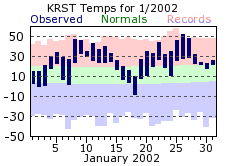 |
| |
|
|
For February, it was another winter month that had temperatures more fitting for early spring. More precipitation fell this month, but because of the warmth, much of what fell came as rain rather than snow. February ended up being the 10th warmest on record, and the 5th wettest. It was also a rather windy February, with winds also more common of the spring rather than winter. On several days, average wind speeds for the day were greater than 20 mph, with wind gusts up to 50. With the end of February also came the end of the unseasonably mild conditions, leading into a rather cool spring. The winter months (Dec-Jan-Feb) of 2001-02 did finish as the 2nd warmest on record.
|
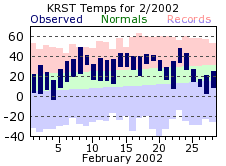 |
| |
|
|
March temperatures took a decided turn downward in Rochester...averaging 5 degrees below normal.
In fact, March was colder than both February and December, and only a degree warmer than January.
The last zero or colder temperature for the winter occurred in March, bringing the total for the season to 7. This is significant as it is the lowest number of zero degree or colder temperatures on record for Rochester for a winter season. Precipitation was fairly normal until mid month. Over the last 11 days of the month, only 0.03 inches of precipitation were recorded.
|
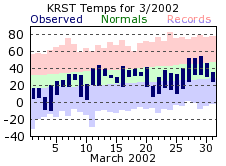 |
| |
|
April was probably the most “confused” of the months in 2002, not sure what season it should emulate or transition to. The month started out cold, with 2 inches of snow falling on the first two days. By the middle of the month, temperatures had climbed well above normal, reaching a June-like 87 degrees on the 15th. Just a mere week later though, 4 inches of snow fell across the Rochester area. The snow wasn’t done either, with an additional inch falling on the 27th. In both cases, high temperatures for the day, along with a relatively warm ground, melted the snow quickly. As expected, it was rather windy at times, with the stretch from the 23rd through 26th especially breezy. Over that 3 day span the winds averaged around 22 mph with gusts approaching 50.
|
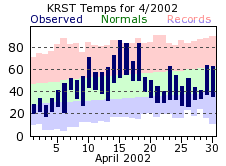 |
| |
|
|
Snow wasn’t a concern for May (although there was some hail on the 8th), and precipitation in general seemed like an after thought. May’s total of 1 ½ inches were 2 inches below normal. It was also rather cool, waiting until the last week of the month to warm into a semblance of summer. The first 90 degree temperature of the year occurred on the 30th. While not as windy as May, one day stands out, with the 9th averaging winds speeds of 27 mph and gusts near 50.
|
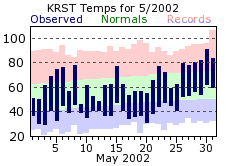 |
| |
|
After a 90 degree start to June, rain and clouds dropped temperatures back to those cool readings of May. The cold stint would be brief though, with highs climbing back into the 80s for most of the remainder of the month. Rain was the main story for June, with over 4 inches more water than usual. The total of 8.20 inches for the month made it the 5th wettest June on record. The wettest stretch was that period at the start of the month, with 3 ½ inches falling on the 3rd and 4th .
|
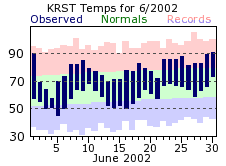 |
| |
|
July stayed warm, although temperatures never cracked the 90 degree barrier. July was also wet, although somewhat deceiving. Through the 17th of the month, only ½ inch of rain fell, with nearly all of that total coming on the 10th. The second half of the month is where this initial deficit was made up for, with measurable precipitation falling on 10 out of the remaining 13 days of the month.
|
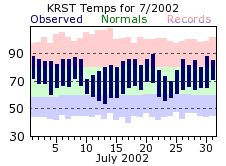 |
| |
|
|
August was the coolest of the summer months, with most days only climbing into the 70s. It was wet again, although there were a couple week stretches near the start and end of the month with nary a trace of rainfall. The wet August helped make the 2002 traditional summer months (Jun-Jul-Aug) the 10th wettest on record, while temperatures were only a bit warmer than normal.
|
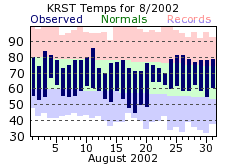 |
| |
|
|
A rather warm start to September lead to the month being above normal for temperatures. High temperatures neared 90 by the second week, but then fell more in step with the seasonable normals for the rest of the month. In fact, the first freezing temperature of the new winter season occurred in September, on the 24th. The wet conditions of the summer did not continue for this first “fall” month, with September’s total over an inch below normal. What rain fell, however, was fairly well distributed throughout the month.
|
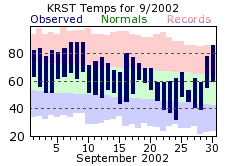 |
| |
|
|
October gave the distinct feel that the calender skipped straight to November, as temperatures averaged over 5 degrees below normal. Mercuries dipped to or below 32 degrees 17 times, while high temperatures were steady in the 30s and 40s for the last half of the month. For precipitation, the first trace of snowfall came on the 16th, while the first measurable snow of the winter season fell on the 24th. The bulk of the wetting for October came in the first few days of the month though, with over 60 percent of the monthly total falling on the 2nd through the 4th.
|
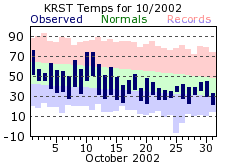 |
| |
|
|
November was rather typical for temperatures, with the average for the month coming in at its normal. There were more freezing days than usual though, with low temperatures at or below 32 degrees on 27 of the 30 days. It was a very dry by November standards, nearly 2 inches below normal, and measurable precipitation only fell on 3 days. The meager total of 0.12 inches made it the 5th driest November on record.
|
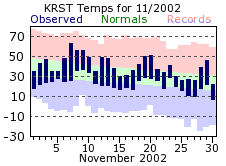 |
| |
|
|
December started off rather chilly, with low temperatures falling into the single digits on 7 of the first 9 days, and below zero on the 5th . After that, however, the mild conditions that have become the norm for recent Decembers returned, with temperatures averaging above normal for the rest of the month. December continued November’s dry trend, recording measurable precipitation on only 5 days. Snowfall also suffered as a result, with less than 2 inches for the month, and a Christmas day without snow. The last “non‑white” Christmas previous to this one was in 1997.
|
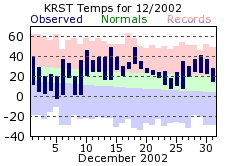 |
| |
|
| |
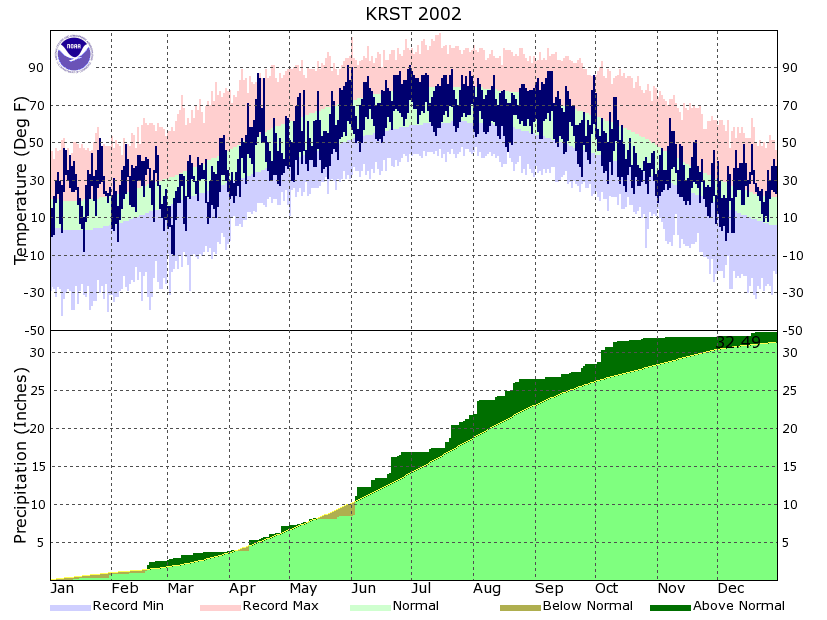 |